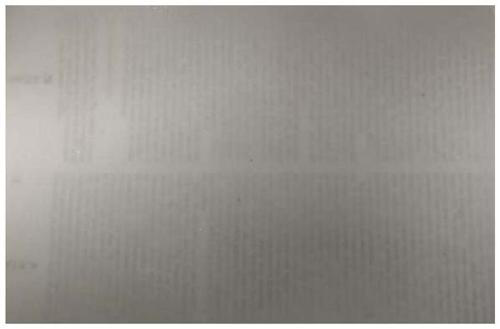A flexible translucent waterproof and heat-insulating film and its preparation method
A translucent, waterproof technology, applied in surgery, diagnosis, medical science and other directions, can solve problems such as injury, achieve low cost, easy production and good protection effect.
- Summary
- Abstract
- Description
- Claims
- Application Information
AI Technical Summary
Problems solved by technology
Method used
Image
Examples
Embodiment 1
[0024] Stir and mix 75 parts of polyether polyol 330, 25 parts of grafted polyether polyol 2045, 1.1 parts of silicone oil and 3.2 parts of water at high speed, then add 46 parts of TDI, stir evenly at high speed, and coat the mixture into a 0.35mm thick The film was naturally cured at room temperature for one day, and then cured in an oven at 100°C for one day to obtain a flexible and translucent film. Spread the film in the air and make it slightly concave in the middle. Drop 0.5mL of boiling water on the film. Tested by an infrared thermal imager, the highest temperature on the other side of the film is 46°C. The heat insulation film is used to protect the recurrent laryngeal nerve during the operation, and the temperature on the back of the heat insulation film is below 43°C when the ultrasonic knife or electric knife is used for routine operation at a distance of 2-3mm from the nerve.
Embodiment 2
[0026] Mix 75 parts of polyether polyol 330, 25 parts of grafted polyether polyol 2045, 0.03 parts of stannous octoate, 10 parts of silicone oil and 2.4 parts of water at high speed and mix well, then add 38.3 parts of TDI, stir evenly at high speed, and mix the mixture It is coated into a film with a thickness of 0.35mm, cured naturally at room temperature for one day, and then cured in an oven at 100°C for one day to obtain a flexible and translucent film. Spread the film in the air and make it slightly concave in the middle, drop 0.5mL of boiling water on the film, and test with an infrared thermal imager, the highest temperature on the other side of the film is 43°C. The heat insulation film is used to protect the recurrent laryngeal nerve during the operation, and the temperature on the back of the heat insulation film is below 40°C when the ultrasonic knife or electric knife is used for routine operation at a distance of 2-3mm from the nerve. By changing the amount of si...
Embodiment 3
[0028] Mix 75 parts of polyether polyol 330, 25 parts of grafted polyether polyol 2045, 0.03 parts of stannous octoate, 10 parts of silicone oil, 1 part of 3-fluoropropanol and 2.4 parts of water at high speed, and then add 39.4 parts of TDI, Stir evenly at high speed, coat the mixture into a film with a thickness of 0.35mm, let it cure naturally at room temperature for one day, and then cure it in an oven at 100°C for one day to obtain a flexible and translucent film. Spread the film in the air, and make the middle slightly concave, drop 0.5mL of boiling water on the film, and test with an infrared thermal imager, the highest temperature on the other side of the film is 41°C. The heat insulation film is used to protect the recurrent laryngeal nerve during the operation, and the temperature on the back of the heat insulation film is below 40°C when the ultrasonic knife or electric knife is used for routine operation at a distance of 2-3mm from the nerve. By adding a hydrophobi...
PUM
| Property | Measurement | Unit |
|---|---|---|
| phase transition temperature | aaaaa | aaaaa |
| size | aaaaa | aaaaa |
| thickness | aaaaa | aaaaa |
Abstract
Description
Claims
Application Information
 Login to View More
Login to View More - R&D Engineer
- R&D Manager
- IP Professional
- Industry Leading Data Capabilities
- Powerful AI technology
- Patent DNA Extraction
Browse by: Latest US Patents, China's latest patents, Technical Efficacy Thesaurus, Application Domain, Technology Topic, Popular Technical Reports.
© 2024 PatSnap. All rights reserved.Legal|Privacy policy|Modern Slavery Act Transparency Statement|Sitemap|About US| Contact US: help@patsnap.com









